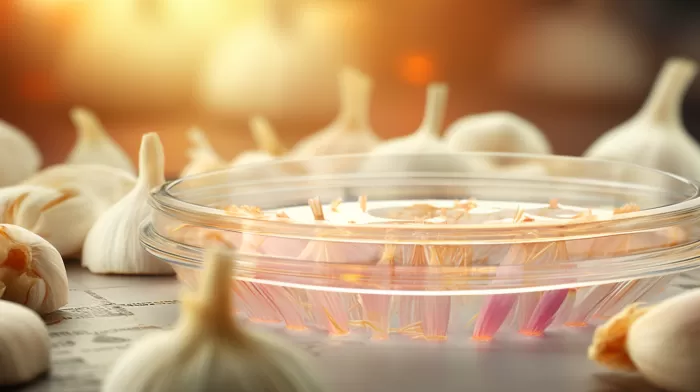Garlic, a favorite culinary ingredient for many, has long been known for its health benefits. Beyond its potential to ward off colds and boost the immune system, garlic is famous for its powerful antimicrobial properties. One of the main medicinal ingredients of garlic is diallyl sulfide, a compound that has recently been shown to fight off Campylobacter – a bacterium responsible for causing intestinal infections.
The Battle with Campylobacter
Campylobacter is a highly resistant bacterium, causing gastrointestinal infections such as diarrhea and food poisoning. In some cases, it can lead to even more severe health issues, such as Guillain-Barré syndrome or reactive arthritis. This pesky bacterium forms a slimy protective biofilm that makes it difficult to eradicate, particularly on food-preparation surfaces.
Scientists have been searching for a way to combat the presence of Campylobacter in our foods and kitchen areas. Antibiotics are frequently used in the fight against such bacteria, but the overuse of antibiotics has led to increased resistance over time, making them less effective.
Garlic to the Rescue
Recent research has discovered that garlic’s diallyl sulfide compound can be used to overcome the previously untreatable bacterium. In a fascinating study, the researchers treated Campylobacter with two common antibiotics and then with the diallyl sulfide compound found in garlic.
The results were astonishing. While the antibiotics did have some effect on the bacteria, the garlic compound was 100 times more effective. Not only did it work faster, but it also managed to infiltrate the slimy protective biofilm and kill the bacterium completely. The practical applications of this finding could be groundbreaking, potentially leading to the integration of diallyl sulfide into cleaning products and food packaging.
Harnessing Garlic’s Benefits
In light of these findings, incorporating garlic into our daily lives as more than just a flavor enhancer is now even more important. Here are a few ways to make the most of this powerful herb:
In The Kitchen
- Try to incorporate garlic into your recipes whenever possible. From pasta sauces to salad dressings, making garlic a staple in your pantry is a smart move toward better health.
- Avoid using pre-chopped or powdered garlic, as these forms miss many of the nutrients and health benefits that fresh garlic offers.
-
Use a garlic press or mince garlic before cooking it. Crushing garlic is known to boost its health-promoting properties.
On Your Health
- Take garlic supplements regularly. If you’re not a fan of the taste or want to avoid smelling like it, garlic capsules are an excellent alternative. They provide the same health benefits without the lingering odor.
-
Join a garlic cooking class. This can be a fun way to learn about the various ways of using garlic for medicinal purposes while expanding your culinary skills and knowledge.
Preventing Foodborne Illness
- Wash hands and food surfaces thoroughly and regularly, especially after handling raw meat or poultry. This is one of the most important steps to minimize the risk of contamination in the kitchen.
-
Avoid leaving food out at room temperature for an extended period of time, as bacteria can multiply quickly in these conditions. Store perishable foods in the fridge or freezer as soon as possible.
-
When preparing meals, use separate cutting boards and utensils for raw meats and other ingredients to prevent cross-contamination.
Conclusion
Garlic’s antimicrobial properties are becoming more significant as antibiotics lose their effectiveness and new methods of fighting harmful bacteria must be discovered. The success of diallyl sulfide against Campylobacter gives hope that natural alternatives may prevail in the ongoing battle against foodborne illness and the spread of infection. In the meantime, making garlic a regular part of your diet and maintaining safe hygiene practices in the kitchen will go a long way in maintaining your overall health.



